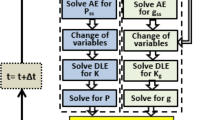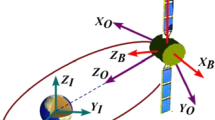Abstract
This paper intends to compare the effect of the attitude parameterization method on the performance of the attitude controller designed with the direct feedback of corresponding attitude states. To achieve this, the proportional-derivative controllers using the finite rotation angles and the modified Rodrigues parameters are designed with the same structure and equivalent performance of the direct quaternion-feedback control. It has been demonstrated through a series of comparative analyses that three different parameterization methods can be commonly used in designing their direct feedbacks for the spacecraft’s attitude control. Next, the effects of the nonlinear transform relations among three parameterizations are thoroughly investigated through the controller-response analyses for an eigen-axis rest-to-rest maneuver with varying the initial angular position. The controller designed with the finite rotation angles shows a consistent performance regardless of the initial angular position. Whereas, those using other two methods show large variations in their response characteristics. From the results, it can be concluded that the direct feedback controller designed with the finite rotation angles outperforms those using the modified Rodrigues parameters or the quaternion, especially when the spacecraft experiences an aggressive maneuver or has a wide operating range of the attitude.









Similar content being viewed by others
References
Wie, B, Barba PM (1985) Quaternion feedback for spacecraft large angle maneuvers. J Guid Control Dyn 8(3):360–365. https://doi.org/10.2514/3.19988
Stuelpnagel J (1964) On the parameterization of the three-dimensional rotation group. SIAM Review 6(4):422–430. https://doi.org/10.1137/1006093
Shuster MD (1993) A survey of attitude representations. J Astronaut Sci 41(4):439–517
Wie B, Weiss H, Arapostathis A (1989) Quaternion feedback regulator for spacecraft eigenaxis rotations. J Guid Control Dyn 12(3):375–380. https://doi.org/10.2514/3.20418
Joshi SM, Kelkar AG, Wen JT-Y (1995) Robust attitude stabilization of spacecraft using nonlinear quaternion feedback. IEEE Trans Autom Control 40(10):1800–1803. https://doi.org/10.1109/9.467669
Cristi R, Burl J, Russo N (1994) Adaptive quaternion feedback regulation for eigenaxis rotations. J Guid Control Dyn 17(6):1287–1291. https://doi.org/10.2514/3.21346
Weiss H (1993) Quaternion-based rate/attitude tracking system with application to gimbal attitude control. J Guid Control Dyn 16(4):609–616. https://doi.org/10.2514/3.21057
Bilimoria KD, Wie B (1993) Time-optimal three-axis reorientation of a rigid spacecraft. J Guid Control Dyn 16(3):446–452. https://doi.org/10.2514/3.21030
Tsiotras P (1998) Further passivity results for the attitude control problem. IEEE Trans Autom Control 43(11):1597–1600. https://doi.org/10.1109/9.728877
Tsiotras P (1996) Stabilization and optimality results for the attitude control problem. J Guid Control Dyn 19(4):772–779. https://doi.org/10.2514/3.21698
Crassidis JL, Markley FL (1996) Sliding mode control using modified Rodrigues parameters. J Guid Control Dyn 19(6):1381–1383. https://doi.org/10.2514/3.21798
Junkins JL, Akella MR, Robinett RD (1997) Nonlinear adaptive control of spacecraft maneuvers. J Guid Control Dyn 20(6):1104–1110. https://doi.org/10.2514/2.4192
Sharma R, Tewari A (2004) Optimal nonlinear tracking of spacecraft attitude maneuvers. IEEE Trans Control Syst Technol 12(5):677–682. https://doi.org/10.1109/TCST.2004.825060
Akella MR (2001) Rigid body attitude tracking without angular velocity feedback. Syst Control Lett 42(4):321–326. https://doi.org/10.1016/S0167-6911(00)00102-X
Bortz JE (1971) A new mathematical formulation for strapdown inertial navigation. IEEE Trans Aerosp Electron Syst 1:61–66. https://doi.org/10.1109/TAES.1971.310252
Nazaroff GJ (1979) The orientation vector differential equation. J Guid Control Dyn 2(4):351–352. https://doi.org/10.2514/3.55888
Sacleux B (1999) Rotation vector-based attitude control design. In: AIAA guidance, navigation and control conference and exhibit, Portland, OR, USA, 1999, pp 1941–1948. https://doi.org/10.2514/6.1999-4311
Pece CAZ (2002) An engineering vector-like approach to attitude kinematics and nominal attitude state tracking control. PhD Thesis Instituto Tecnologico de Aeronautica Sao Jose dos Campos, SP, Brasil
Kim CJ, Hur SW, Ko JS (2017) On the use of finite rotation angles for spacecraft attitude control. Int J Aeronaut Sp Sci 18(2):300–314. https://doi.org/10.5139/IJASS.2017.18.2.300
de Ruiter AD, Damaren CJ (2001) Effect of attitude parameterization on the performance of passivity-based adaptive attitude control, AIAA Guidance, Navigation and Control conference and Exhibit, Montreal. Canada. https://doi.org/10.2514/6.2001-4154
Casey RT, Karpenko M, Curry R, Elkaim GH (2013) Attitude representation and kinematic propagation for low-cost UAVs. In: AIAA guidance, navigation and control conferences, Boston, MA. https://doi.org/10.2514/6.2013-4615
Ventura J, Romano M, Walter U (2015) Performance evaluation of the inverse dynamics method for optimal spacecraft reorientation. Acta Astronaut 110:266–278. https://doi.org/10.1016/j.actaastro.2014.11.041
Stevens BL, Lewis FL, Johnson EN (2015) Aircraft control and simulation: dynamics, controls design, and autonomous systems. Wiley. https://doi.org/10.1002/9781119174882
Acknowledgements
This work is supported by the Korea Agency for Infrastructure Technology Advancement (KAIA) grant funded by the Ministry of Land, Infrastructure and Transport (Grant 20CHTR-C139566-04).
Author information
Authors and Affiliations
Corresponding author
Additional information
Publisher's Note
Springer Nature remains neutral with regard to jurisdictional claims in published maps and institutional affiliations.
Appendix
Appendix
This appendix intends to show how accurate kinematics associated with three-parameter finite rotation angles can be obtained without singularity when the attitude \(\theta\) approaches zero. For this purpose, function values used in the kinematics, such as \({\mathbf{f}}(\theta )\) and \({\mathbf{g}}(\theta )\), are approximated using the Taylor series expansion of trigonometric functions, as shown in Eqs. (29) and (30) [23]. Less than four terms are enough to achieve the machine precision when \(\theta\) becomes less than 1 degree.
Applying the above equations to Eqs. (4) and (10), the functions used in the kinematics can be approximated using (31) to accurately estimate \({\mathbf{T}}\) and \({\dot{\mathbf{\theta }}}\) when the angular displacement is small enough.
Rights and permissions
About this article
Cite this article
Hur, S.W., Lee, S.H. & Kim, CJ. Effects of Attitude Parameterization Methods on Attitude Controller Performance. Int. J. Aeronaut. Space Sci. 22, 176–185 (2021). https://doi.org/10.1007/s42405-020-00286-3
Received:
Revised:
Accepted:
Published:
Issue Date:
DOI: https://doi.org/10.1007/s42405-020-00286-3




